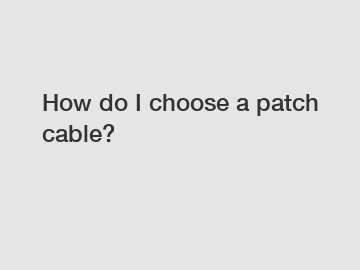How do I choose a patch cable?
In this era of advanced technology and interconnected devices, patch cables have become an essential component in establishing seamless connections. Whether you're setting up a home network, audio system, or even a complex data center, selecting the right patch cable is paramount. With so many options available, it's easy to get overwhelmed. However, fear not! In this comprehensive guide, we'll walk you through all the important factors to consider when choosing a patch cable that suits your specific requirements.
1. Understanding Patch Cables:
Before diving into the nitty-gritty details, let's first clarify the purpose and function of patch cables. These short, flexible cables transmit electronic signals between devices or components in various systems, ensuring efficient data transfer. They are commonly used to connect computers, routers, switches, modems, audio systems, and much more.

2. Cable Type:
The first step in choosing a patch cable is determining the appropriate cable type. There are various options available, each suited for specific applications. Let's explore the most common ones:
a) Ethernet Cables: These cables are primarily used in networking setups to establish connections between devices such as computers, switches, and routers. They come in different categories (Cat5e, Cat6, etc.) that offer varying speeds and bandwidth capabilities.
b) Coaxial Cables: Coaxial cables are primarily used in audio and video systems. They provide excellent signal quality, making them perfect for connecting TVs, speakers, cameras, and other multimedia devices.
c) Fiber Optic Cables: Ideal for high-speed data transfer over long distances, fiber optic cables use light signals rather than electrical currents. As a result, they offer superior speeds and reliability, making them suitable for data centers, ISPs, and broadcast systems.
3. Cable Length:
Once you've determined the type of cable you need, consider the length required to establish the desired connection. Avoid unnecessary clutter by selecting a cable that is appropriately sized for your specific setup. If in doubt, it's always better to choose a slightly longer cable than needed, as excessive tension or stretching could diminish performance.
4. Connector Type:
Patch cables come with a variety of connector types at both ends. The most common ones include:
a) RJ-45: This connector is widely used in Ethernet cables and is usually associated with networking devices.
b) RCA: RCA connectors are typically found in audio or video cables and provide excellent analog signal transmission.
c) XLR: XLR connectors are commonly used in professional audio setups, offering balanced connections and high-quality sound transmission.
5. Shielding:
Consider the shielding requirements for your specific application. Shielding provides protection against electromagnetic interference (EMI) and radio frequency interference (RFI). Generally, it's recommended to opt for shielded cables in high-noise environments, such as data centers or areas with numerous electronic devices.
6. Cable Quality:
Choosing a high-quality cable might come at a slightly higher cost, but it can significantly impact the overall performance and longevity of your system. High-quality cables are less prone to signal degradation, offer better durability, and ensure a more reliable connection over time.
7. Compatibility:
Ensure that the patch cable you choose is compatible with the devices or systems you plan to connect. Check the specifications of your equipment and make sure they align with the characteristics of the cable you're considering.
8. Cost vs. Value:
While it's tempting to opt for the most affordable cable option, consider the long-term benefits of investing in a higher-quality product. Spending a bit more upfront can save you from having to replace cables frequently or experiencing signal loss issues in the future.
Conclusion:
Choosing the perfect patch cable requires careful consideration of various factors, including cable type, length, connector type, shielding, quality, and compatibility. By understanding your specific requirements and following the guidelines outlined in this article, you'll be well-equipped to make an informed decision. Remember, a well-chosen patch cable can significantly enhance the efficiency, performance, and reliability of your connected systems. So, whether you're a home user, business owner, or IT professional, take the time to select the right patch cable and reap the benefits of seamless connectivity.
The company is the world’s best Multichannel Audio Cable Supplier, China Fiber Optic Manufacturer, Photoelectric Composite Cables supplier. We are your one-stop shop for all needs. Our staff are highly-specialized and will help you find the product you need.

Comments
0